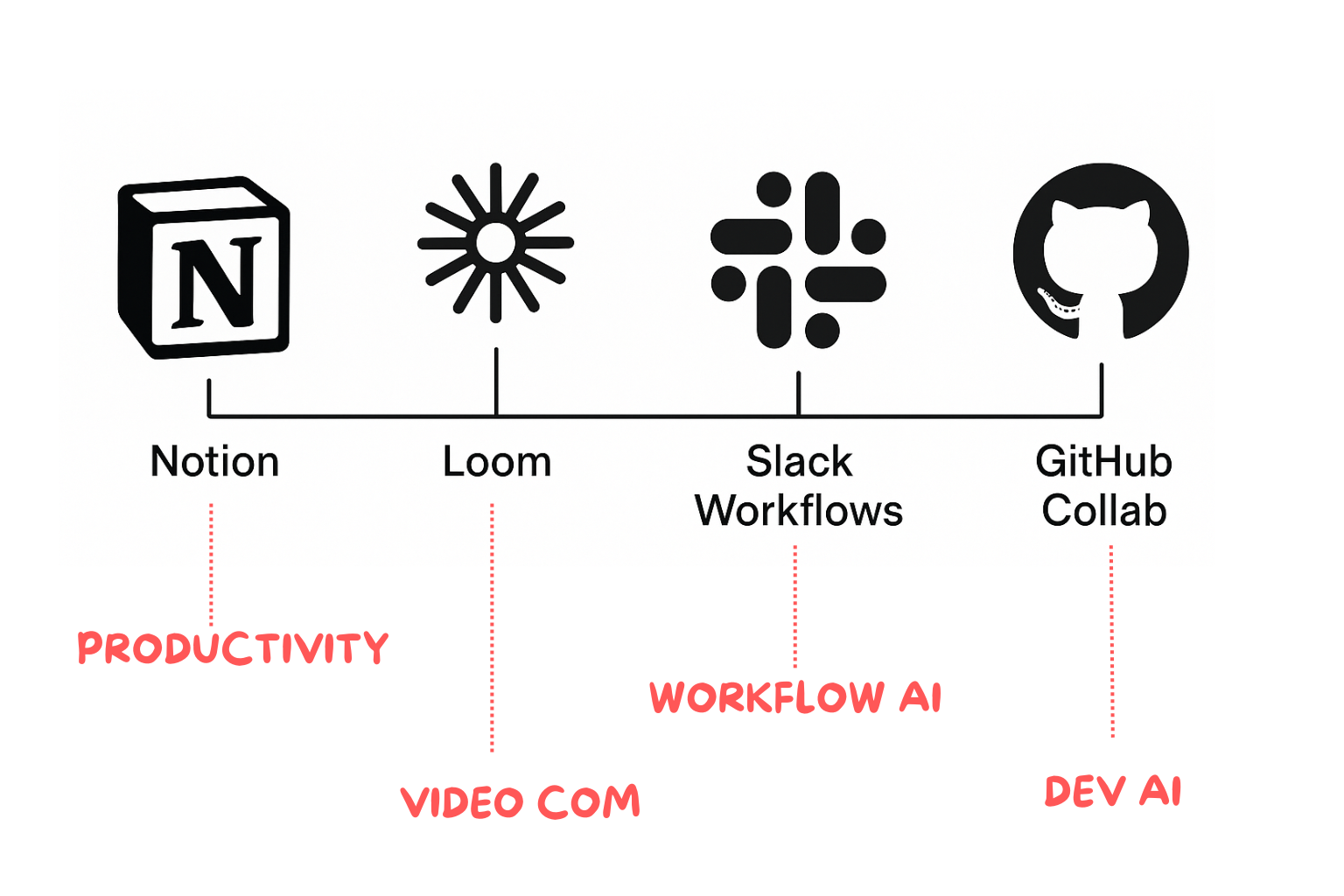Aagya Khatri on May 23, 2025
Reading Time: 7 Min
With your sales team based in New Jersey and a development team operating remotely from India or Nepal—nearly halfway around the world in an opposite time zone—communication gaps are almost inevitable. These may include misunderstandings, delayed responses, and missed deadlines due to limited overlap and reduced real-time collaboration.
However, it should never become the top of your problems list! If two or more teams cannot work together, your enterprise will likely fail. Fortunately, there are ways you can identify these problems before they become troublesome.
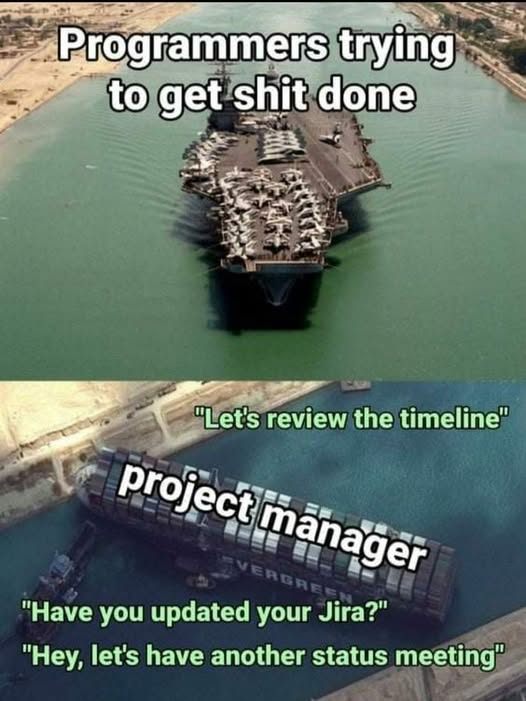
How to Bridge the Communication Gap between In-house and Offshore Teams
Begin by evaluating how well your teams collaborate—look at how frequently they exchange project updates, how promptly they respond to issue tickets, and how effectively remote teams manage tasks and changes. If you notice inconsistent updates, delayed responses, or unclear ownership, these are strong indicators of a communication gap.
To bridge that gap, consider implementing overlapping work hours, defining clear communication protocols (e.g., when to use async tools like email vs. sync tools like Zoom), and standardizing tools across teams like Slack, Zoom, and Jira. Support this with structured documentation, cultural onboarding, and, when needed, appointing a liaison or tech leads to act as a bridge between in-house and offshore teams.
Of course, this is easier said than done. While these solutions may sound effective, identifying the root cause of a communication issue can often be more challenging than solving it. That’s why understanding communication gaps, why, how, and what is critical.
Let’s break it down to help you not just solve—but spot—the problem early.
1. Understanding the Root Cause(s)
Collaborating across different time zones can hinder real-time communication. So, the first step in fixing the communication gap is to identify its causes.
Most often, the cause may be a combination of two or more problems. Let us find out!
Key Root Causes of Communication Gaps
- Time Zone Mismatches: The longer the time differences, the slower the feedback loop. For example, a 12-hour gap can lead to a 1–2 day delay in resolving simple issues, which could have been resolved within a few hours, often leading to delays.
- Language and Cultural Barriers: Language proficiency varies among team members, leading to potential misunderstandings, especially while using asynchronous communication tools. Moreover, cultural differences may influence communication styles and perceptions, affecting collaboration among colleagues.
- Lack of Face-to-Face Interaction: Messages can be misinterpreted or not understood properly without visual indications. Remote teams also lose trust-building conversations and relationships.
- Tool Misalignment: Team members using different platforms for tracking progress or communication may create silos, delaying progress. For example, developers may log progress in Trello, while managers may use Jira. In this case, the manager may miss the progress updates, requiring frequent updates.
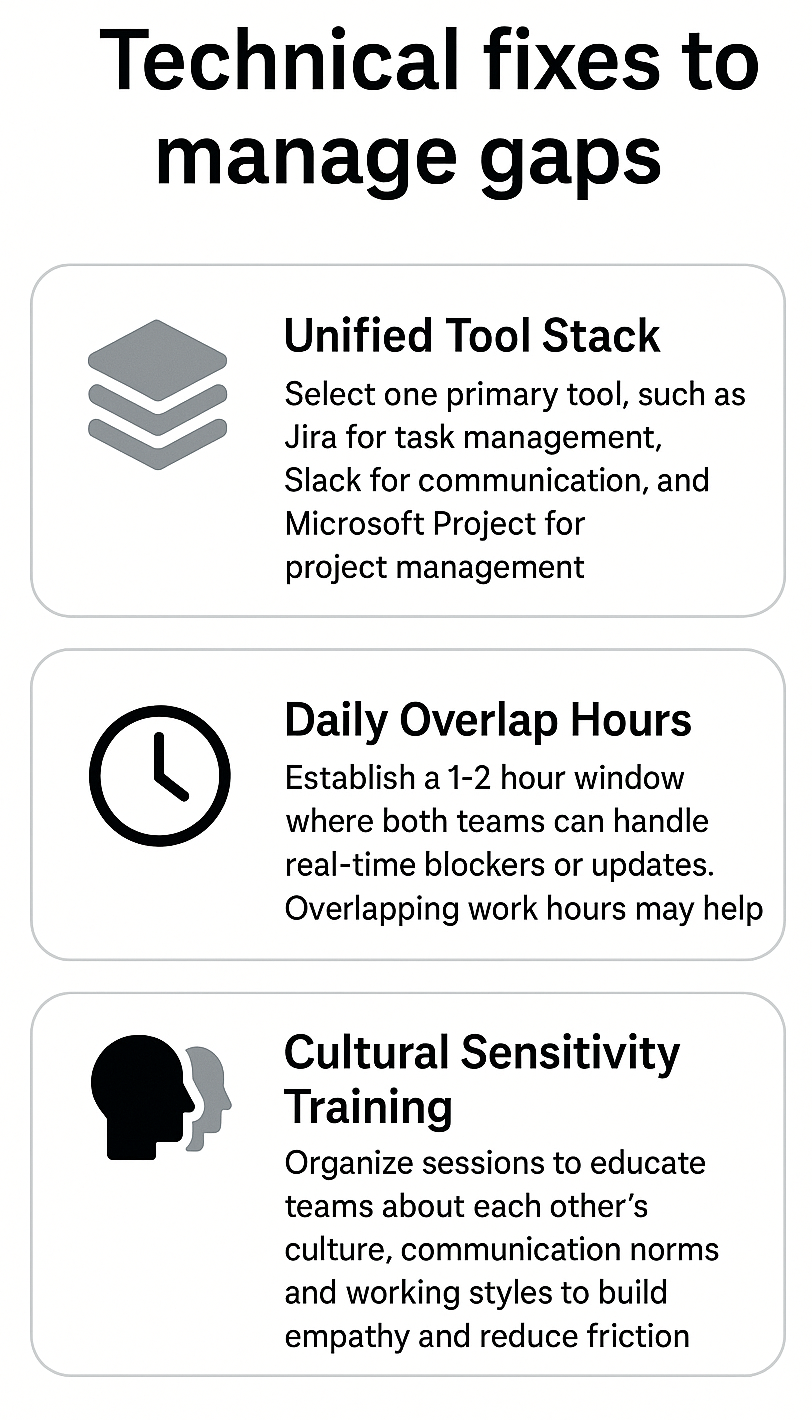
2. Clarifying Expectations from Day One
Clarity is the antidote to confusion, especially when one team creates and another team sells. Misaligned targets may set back the production team, requiring numerous iterations and leaving the sales team unoccupied.
When teams understand what is expected of them from the start, they become more attuned to productivity, reducing unnecessary iterations and lag in response related to progress updates.
Strategies to Clarify Expectations
- Define Roles and Responsibilities: Allocating who does what using frameworks like RACI (Responsible, Accountable, Consulted, and Informed) avoids overlaps and confusion.
- Set Communication Protocols: Establish how updates should be delivered, e.g., daily stand-ups via Zoom, progress reports on Slack, and urgent issues over email.
- Document Everything: Store Standard Operating Procedures (SOPs), coding guidelines, and workflow diagrams in central hubs like Notion or Confluence to facilitate onboarding.
- Modify Agile Methods: Introduce flexible sprint planning, asynchronous retrospectives, and bi-weekly check-ins.

3. Implementing Strategic Project Management Solutions
Even the most talented offshore team can struggle without a solid project management plan.
An effective project management strategy is the backbone of any successful offshore engagement. It is not just about deadlines but structure, clarity, and accountability.
Moreover, when tasks are visible, and timelines are clear, everyone can focus on outcomes instead of confusion.
Proven Project Management Frameworks
- Scrum + Async Updates: Keep Scrum ceremonies like sprint planning and retrospectives, but allow daily check-ins via shared docs or videos.
- Kanban for Visual Workflows: Use Kanban boards to visualize work-in-progress, blockers, and completed tasks.
- Hybrid Models: Blend Waterfall planning phases with Agile execution to benefit from clarity and flexibility during development.
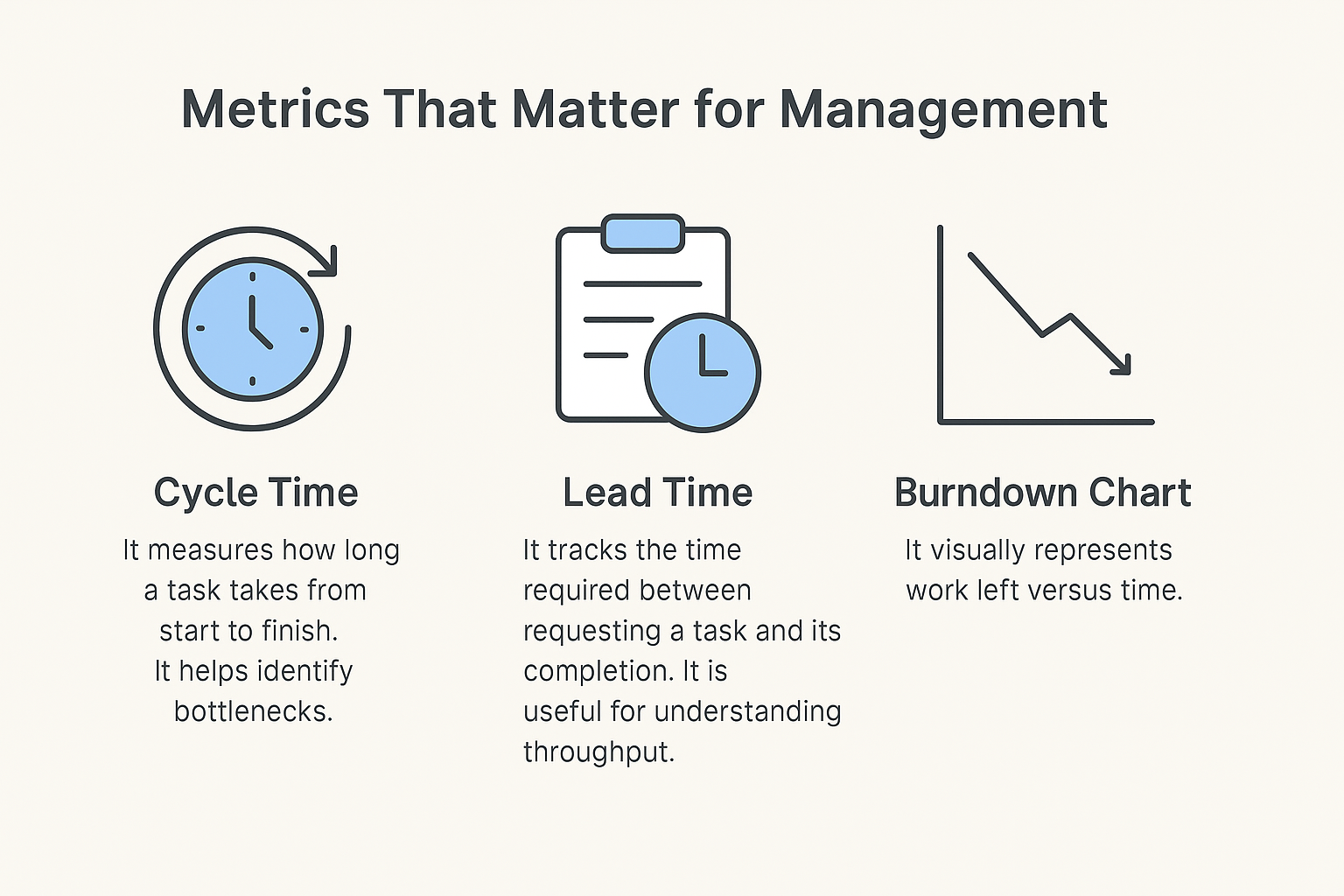
Tools
- Jira: It is a comprehensive software platform for planning, tracking, and releasing.
- ClickUp: It offers docs, task lists, timelines, and dashboards in one place.
- Toggl Track: It monitors time spent across tasks to evaluate efficiency.
- Miro: It is a collaborative whiteboard for visual planning, wireframing, and brainstorming.
4. Building a Feedback-Driven Culture
In distributed teams, feedback becomes essential, not optional. Regular feedback builds trust, solves issues faster, improves teamwork, and helps everyone feel aligned with project goals.
The teams can raise issues in each sprint and create appropriate tickets to address accordingly, which may quickly help resolve differences.
Tactics
- Weekly 1:1s: Encourage one-on-one sessions between team leads and developers to address challenges, provide mentorship, and synchronize tasks.
- Retrospective Meeting: Structuring the project around three questions: What worked well? What did not? What can be improved?
- Recognition and Rewards: Show appreciation for achievements through gestures, virtual badges, public shout-outs, or performance bonuses.
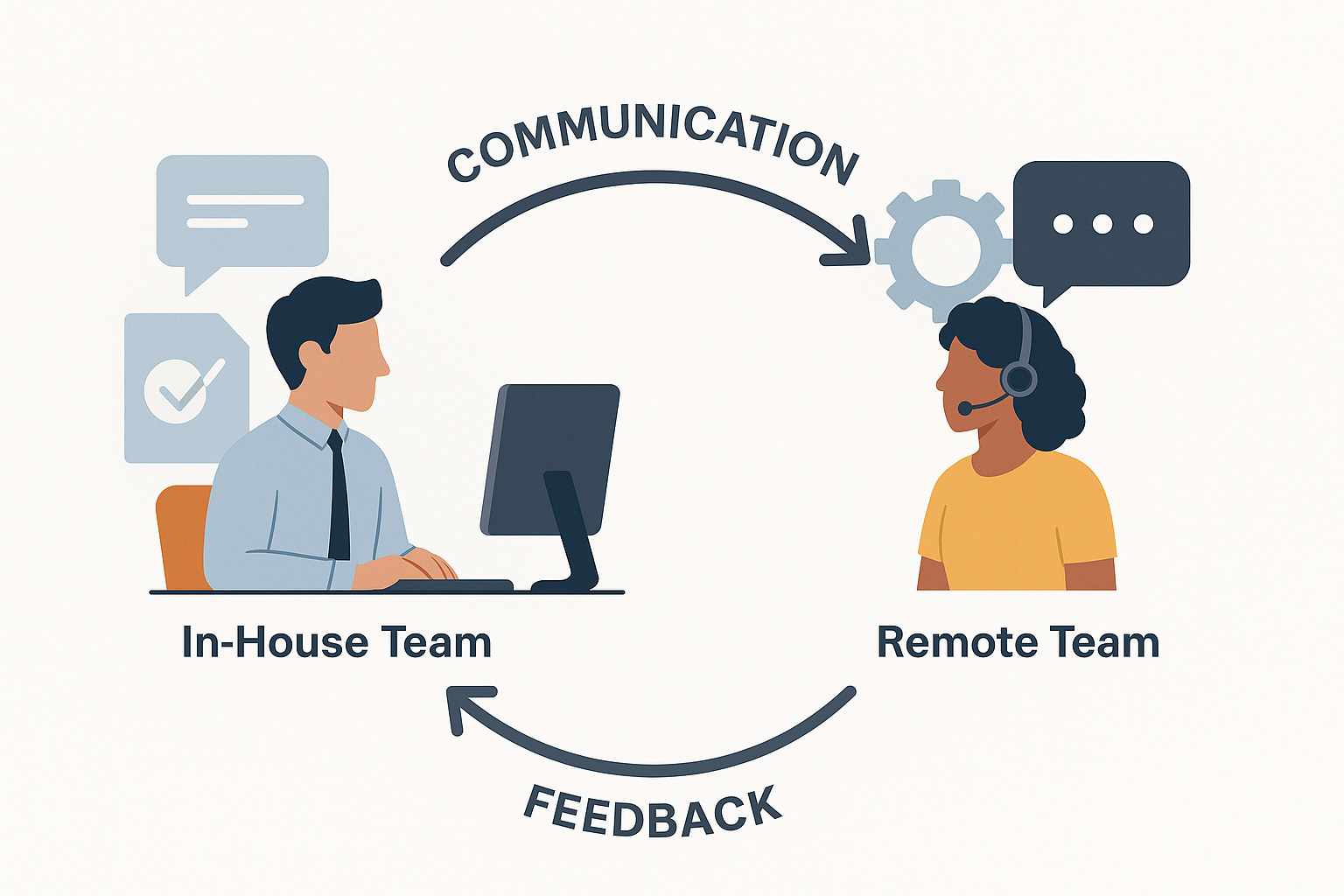
Tools
- Officevibe: It allows anonymous surveys and feedback collection to gauge team sentiment.
- 15Five: It tracks goals, provides continuous feedback, and encourages employee development.
- Kudos in Slack: It is a lightweight, effective public recognition and team bonding tool.
5. Leveraging AI and Automation
AI can simplify distributed teams by minimizing repetitive tasks and enhancing decision-making using ML models and data analytics.
Whether summarizing meetings or translating messages, AI-driven tools free up time and create more space for deep work. Adopting Applied AI models will help the teams collaborate on creating and testing MVPs, while Agentic AI tools will help with micro projects.
However, you must comprehend the problem and its solution before applying AI/ML tools, as acquiring one can be costly.
Tips to Incorporate AI and Automation
- Automated Meeting Notes: Tools like Otter.ai and Fireflies record and summarize meetings so no one misses critical information.
- Language Translation: Integrate services like DeepL or Google Translate within team chat apps for multilingual support.
- AI Assistants: Tools like ChatGPT for quick documentation or GitHub Copilot to speed up coding tasks and improve accuracy.
- Agentic AI: Agentic AI tools can help with micro-projects like rectifying grammatical errors, creating charts, icons, and content, and others.
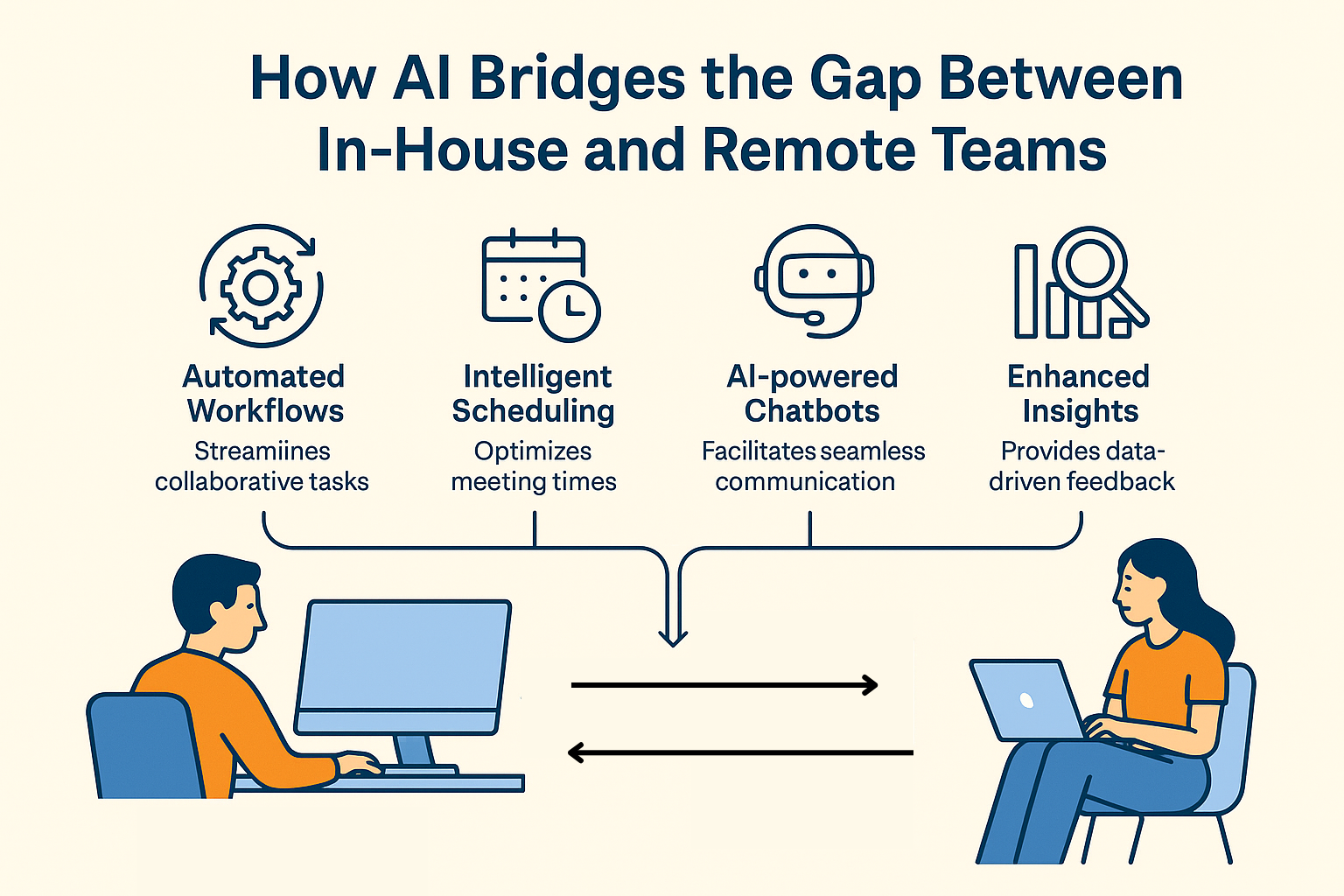
Solutions in a Nutshell
A communication gap is not just about location but clarity, alignment, and empathy. Bridging it requires systems, tools, and a human touch.
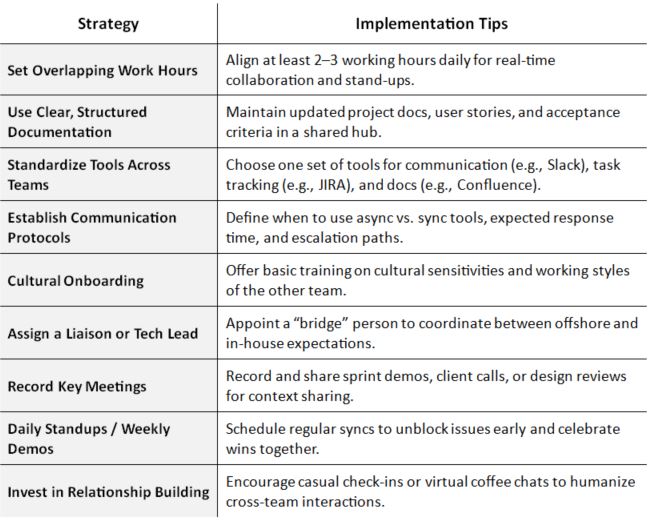
Example:
If your in-house team is in New York and your offshore team is in Nepal, here is how you can bridge the gap between the two teams.
- Plan a daily standup at 9 AM EST (7:45 PM NPT)
- Use Slack + Google Meet for communication and JIRA + Confluence for project tracking.
- Record demos and use a shared Notion or Confluence page for “business context” and product goals
Conclusion
Offshore teams can either be your strongest asset or your biggest challenge.
By handling proper communication, setting crystal-clear expectations, and applying structured project management, your offshore collaboration can become fuel for success in the global marketplace.
Do you want to experience effective offshore teamwork? Team up with Searchable Design, the best remote IT agency supporting West Des Moines projects.
Comments(0)
Your email address will not be published. Required fields are marked *
Recommended Posts
Unlock the Secret of Power BI to Empower Your Data Analysis
Turn Raw Data into Real-Time Intelligence with Power BI
How to Empower Your Web Development Project in 2025?
Empowering Your Web Build with the Right Strategy, Stack, and Global Talent Network
6 Tips for Selecting the Best Offshoring Team for IT Roles
Smart Scaling Starts Here: How to Choose Offshore Talent Without Compromise
RECOMMENDED TOPICS
TAGS
- offshoring
- outsourcing
- web development
- data analytics
- it support
- offshore
- insurance
- seo
- web security
- project management
- pms
- project management system
- agile methodology
- data
- data centric approach
- customer insight
- it infrastructure
- it sustainability
- cloud computing
- agentic ai
- artificial intelligence
- business process automation
- voice search optimization
- outsource
- global talent pool
- techical consulting
- power bi
- business intelligence
- digital marketing
- backoffice
- communication
- insurtech
- remote team
- it roles
- data engineering
- data engineer
- content development
- business development
- offshore talent
- legacy software
- data decision
- off
- test
About
Data Not Found
NEWSLETTER
Related Posts
6 Tips for Selecting the Best Offshoring Team for IT Roles
Smart Scaling Starts Here: How to Choose Offshore Talent Without Compromise

